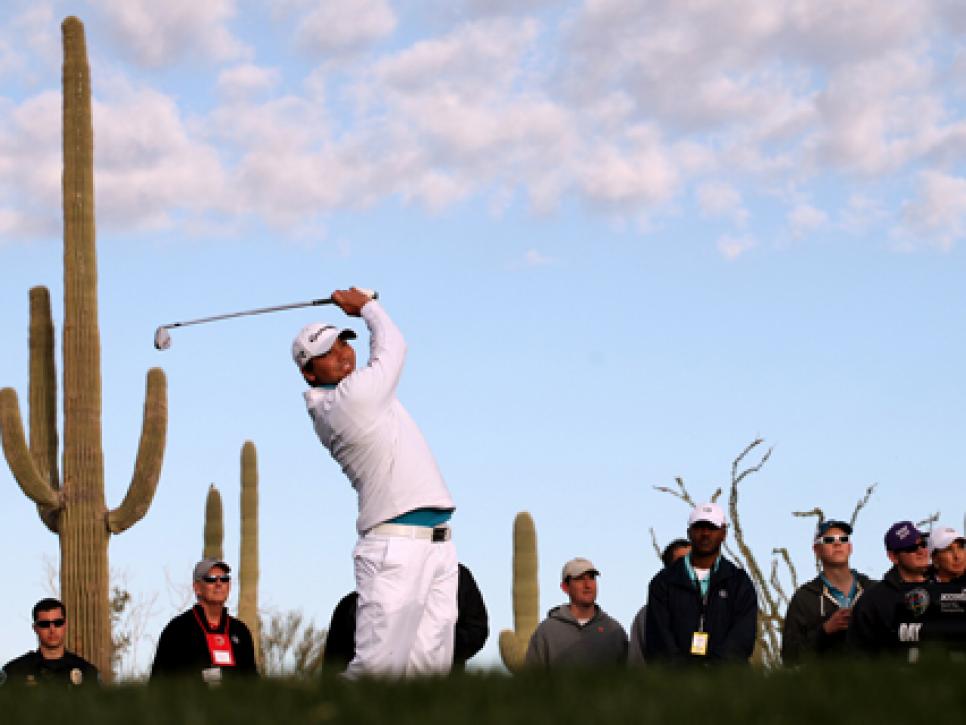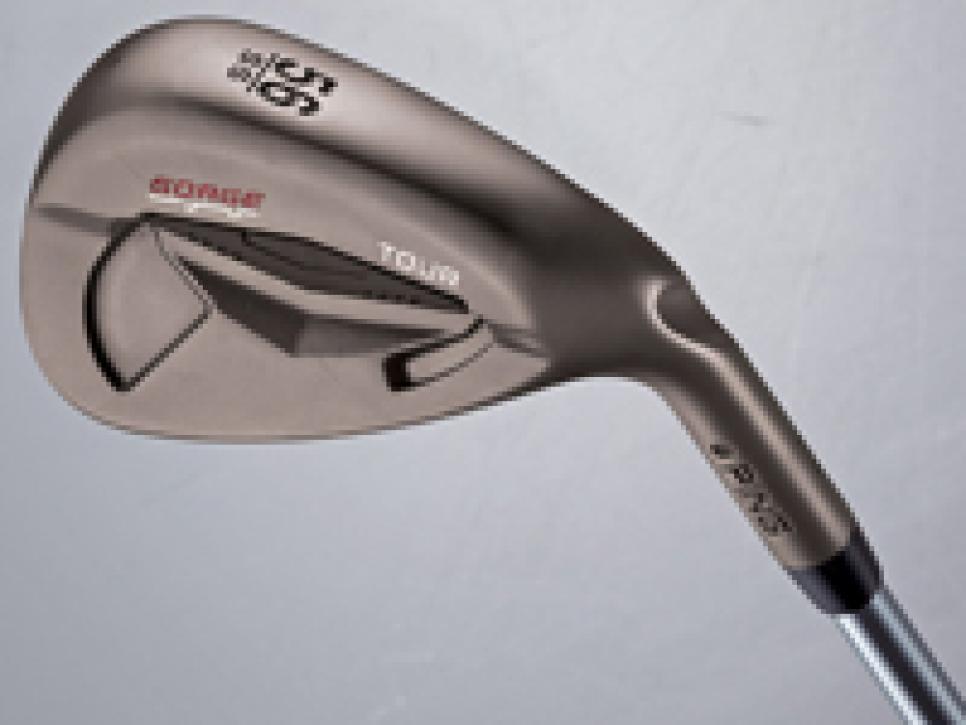The Loop
Cold facts about golf balls
On the first hole of his semifinal match against Matt Kuchar at the WGC-Accenture Match Play, Jason Day had an iron shot from 166 yards into the green. Although Day pulled his approach, it normally would have carried onto the green. On this day, however, it was short, landing in the greenside bunker.
Golf Channel's Frank Nobilo quickly offered an explanation. "That's a freezing cold golf ball," he said. "You have to take that into consideration." Indeed, you do.

Jason Day at the WGC-Accenture Match Play Championship. Photo by: Andy Lyons/Getty Images
As the players began their semifinal matches, the temperature at the GC at Dove Mountain in Marana, Ariz., was a nippy 42 degrees and actually dropped to 39 degrees at one point.
What Day experienced, and what Nobilo was talking about, is not a mere myth. Cold weather affects golf balls due to the coefficient of thermal expansion. Although it may take a Ph.D. to fully understand this, the short version is that materials expand or contract depending on the temperature, thus affecting their properties.
A chill in the air also affects the ball after it is struck. Cold air is denser than warm air and creates additional drag on the ball. Former USGA technical director Frank Thomas has said the difference is about two yards of carry for every 10 degrees change in temperature. Going by Thomas' math, you're looking at a loss of six yards if you're playing in the 42-degree temps they had at the Match Play as opposed to 72 degrees -- or the difference between Day's ball finding the green on the first hole or finding the bunker.
Dean Snell, senior director of R&D, golf balls for TaylorMade, thinks Thomas' figures are about right. "When the golf ball gets colder, it can lose a few miles per hour in ball speed, which can mean distance loss due to speed," said Snell. "[The] optimum temperature range is 70 to 90 degrees. At 40-degree temps the ball can slow down and be shorter by 5 to 10 yards. But the balls are not 40 degrees when played. It takes a while for them to completely get to 40."
Snell added that cold temperatures also have an effect on other elements of the game. Players usually wear bulkier clothing and their bodies are not as flexible, further reducing swing speed that can result in fewer yards. How good a job golfers do at keeping their ball out of the frigid air also plays a role. For tour pros, that is often not an issue. Everyday players, however, tend to leave golf bags -- and balls -- in the trunks of cars, meaning they head to the first tee with golf balls considerably colder than room temperature.
In a 1980 Golf Digest article, Dr. Cary Middlecoff pointed out that, "At the Crosby, where it is almost always cold, I used to put a dozen balls under the radiator in my room to warm them up, then I'd alternate balls every other hole." In the same piece Bob Toski said cold weather affected grips as well, causing them to become hard and making the shaft feel stiffer. "I just had no feel at all with them," said Toski. Granted, Middlecoff and Toski played in the balata-ball era, but even modern players switch balls during cold weather, with some, such as Phil Mickelson, occasionally changing to a different model.
"I've changed to softer, lower compression balls when it is cold," said Mickelson at the Waste Management event in 2011. "A softer ball compresses more easily in the cold."
The tips section of Golfsmith's website offers advice on how to keep golf balls warm, including putting a towel in the bottom of a pot of two quarts of water, bringing the water to 120 degrees Fahrenheit (about the temp of really hot tap water), leave them in there for 30 minutes and then dry them and place them in an insulated food bag.
A check of the Decisions on the Rules of Golf reveals doing this is perfectly legal. Decision 14-3/13.5 essentially states that while golf balls warmed during a round are a breach of Rule 14-3, balls warmed prior to a round are OK. Doing so might keep you out of the front greenside bunker.
TOUR STORIES

It shouldn't surprise anyone that Ian Poulter had 11 new Cobra clubs in his bag at the WGC-Accenture Match Play: a red ZL Encore driver, an AMP Cell 3-wood, a pair of AMP cell hybrids and AMP Cell Pro irons, plus a gap wedge. It also shouldn't come as a shock that Poulter tried some 300 clubs to create his new bag. After all, the Englishman's home in Orlando has an indoor simulator, two launch monitors, a putting green, club-repair bench and a swing-video camera system.
Poulter is a hands-on guy when it comes to his equipment, sometimes doing his own re-gripping (in which he places three layers of tape under his left hand and five layers under the right hand to offset the taper of the shaft, making the grip feel the same size in both hands). The extensive testing for his new clubs was essentially an extension of that.
"I think I'm probably more prepared than I've ever been," said Poulter at the GC at Dove Mountain. "The work I've done in the off-season, the equipment change, changing new shafts in all my irons, knocking a 5-wood out of the bag and putting in an extra wedge in the gap that I had. ... With the shafts [Project X Pxi 6.5] making my ball fly a bit higher, I can get at more pins as well."
NEW STUFF

PRICE: $130 (Seven lofts from 47 to 60 degrees)
A trio of sole options (standard, thin and wide) offers variety while a new manufacturing process provides deeper, sharper-edged grooves. Hunter Mahan used the wedges at the WGC-Accenture Match Play.
BAG ROOM
WGC-Accenture Match Play runner-up Hunter Mahan nearly enjoyed the same result as last year, but did so with a decidedly entirely different set of clubs. The lone holdover: his Ping i15 17-degree hybrid. Mahan also had a new addition at Dove Mountain -- he changed shafts in his Ping G25 3-wood to a Graphite Design Tour AD series that he said launched higher and spun less. ... Some players took advantage of the altitude at the GC at Dove Mountain, which sits 2,600 feet above sea level, by upping the loft on their drivers. Among those seeking a boost were Rory McIlroy, who jumped the loft on his Nike VR_S Covert Tour driver to 10.5 degrees; Rickie Fowler, who went from 7.5 degrees to 8.5 degrees in his Cobra AMP Cell Pro; and Lee Westwood, who went up half a degree in his Ping G25. All three use drivers that are adjustable for loft, making it an easy change. ... Graeme McDowell had two 5-irons in his bag at the Match Play -- a Srixon Z-TX Forged 5-iron as well as a Cleveland 588 MT 5-iron that replaced his 4-iron. McDowell had the club (which features a hollow construction and is akin to a utility iron) built 1/4-inch longer than his normal 5-iron. "It's stupid easy to hit," he said.

